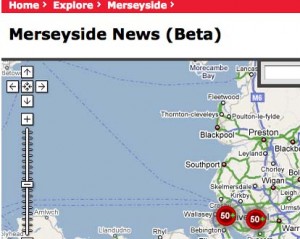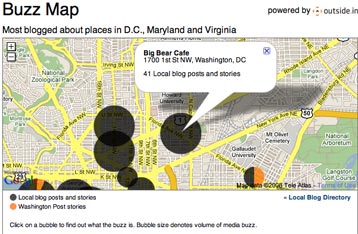Outside.in, the US-based hyperlocal content and advertising platform, has closed a $7 million B round of financing, led by Union Square Ventures and including CNN Worldwide, the company announced yesterday. paidContent has information from its CEO and the release in full. Full post at this link…
Tag Archives: outside in
Jon Bernstein on hyperlocal: Five steps to kick-start the local news revolution
The strength of hyperlocal is also its weakness – disparate projects in far-flung places.
But here’s the thing. What works in KW1 – the business model, the editorial proposition – is likely to work just as well in TR19.*
So we have a choice. Wait for exemplars of the form to rise up, then copy and adapt, or give the whole process a hand by collating, sharing, talking and learning. Right now.
Let’s do the latter. Here’s a quick and dirty call to action:
1. Find out what’s out there
In the United States they are doing just that.
The City University of New York Graduate School of Journalism has invited ‘bloggers, independent journalists, website publishers and entrepreneurs’ to complete a survey so it can ‘gather information and innovative ideas from across the country’.
“We want to bring facts, figures, and business analysis to the debate over the future of journalism,” it states.
Where’s the equivalent effort over here?
I’m told that there are voices in Ofcom, the media regulator, who want to collate information about all of the little community newsletters and bigger sites which could now be called hyperlocal.
If that’s the case, it’s time to get moving. Oh, and we’ll have some of that US data when it’s ready, too.
2. Share ideas
Good practice, sound business models, strong feature strands and story hooks are not geographically-defined. So share, feed off each other, beg, borrow and steal.
Talk About Local is a good start. More, please.
3. Share resources
Can you apply the franchise model to the hyperlocal? For some the answer is a definite yes.
Again Talk About Local offers a possible lead with its plan to seed 150 sites in deprived areas nationwide.
Paul Bradshaw and Nick Booth’s Help me Investigate, is another service with franchise potential.
As is Mapumental.
This is a MySociety.org concoction and, like Help me Investigate, is a recipient of 4iP seed funding. Mapumental is postcode-based tool that brings together publicly available local house price and transport data and mashes it up with a ‘scenicness’ rating .
MySociety is also responsible for FixMyStreet. Both are centrally-built pieces of software with a hyperlocal application.
Integration is the key.
4. Share content
Like franchising, syndication is another old media model that has a home in the brave new world of hyperlocal.
And there is a commercial opportunity for those who create usable aggregation models.
Take Outside.in which has just launched a service in the United States it claims ‘will allow users to quickly create a mass amount of hyperlocal news pages’.
Outside.in is coming to the UK, but why isn’t a UK start-up doing this for the UK market? Perhaps one is. Time to make some noise.
5. Engage government
There’s a crisis in the public service provision of local news. If you want proof just look at the horse-trading between ITV and Ofcom. It’s a perfect opportunity for the government to think laterally.
Yet despite the warm words – and suitable use of new media lingua franca – in last month’s Digital Britain report, Lord Carter and co failed to put anything radical in train.
Carter’s defence is that this report was a sprawling undertaking and wasn’t designed to mandate government.
If so, someone needs to pick it up in Whitehall, but also in county halls up and down the country.
Rather than fund me-too freesheets that threaten to kill off local newspapers, local authorities would be better advised to help provide the infrastructure for hyperlocal.
It’s time to free your data for postcode-based applications, create a support system for local citizen journalists and use those soon-to-be-thriving platforms to promote the uptake of online public services.
Enough of the action plan. Go create.
(*That’s John O’Groats to Land’s End, postcode fans. Well, near enough.)
Jon Bernstein is former multimedia editor of Channel 4 News. This is part of a series of regular columns for Journalism.co.uk. You can read his personal blog at this link.
New York Times: Focus on hyperlocal US news sites
Article rounding-up the state of several hyperlocal news start-ups in the US, including Everyblock, Outside.in, Placeblogger and Patch.
Such sites face an advertising paradox, suggests the article: they offer more targeted readers to advertisers, but fewer of them.
stevenberlinjohnson.com: The crucial ecosystem of technology news
From a speech by Steven B. Johnson, co-founder of Outside.in, at the South by South West Festival:
“I think it’s much more instructive to anticipate the future of investigative journalism by looking at the past of technology journalism (…) It is the old-growth forest of the web. It is the sub-genre of news that has had the longest time to evolve.”
Outside.in: Aggregate, curate and network for a new model of news
From Mark Josephson on the Outside.In blog: an outline of three pillars for a new model of news: ‘aggregate, curate and network’.
“We think there’s an opportunity for a virtuous circle where publishers connect with local bloggers and content to bring hyperlocal content and ad impressions to the publisher and traffic and revenue to the bloggers. Make no mistake, if a new model is going to be successful it needs to be a two-way street,” he writes.
NBC and Outside.in match EveryBlock and NYTimes partnership
It’s all about microlocal/ultralocal/hyperlocal news – or whatever you want to call it – this week with a political news partnership for the New York Times and street-by-street news service EveryBlock.
The two sites have formed a data partnership, with info from the Times’ Represent catalogue of local elected representatives feed into EB’s mapped, postcode-searchable New York site.
Local news aggregation service outside.in has signed a similar deal with NBC ‘s local media network and built 650 ‘neighbourhood news pages’ as part of NBC’s ‘Local Only’ sites.
The pages, which cover nine cities, will feature news and ‘conversation’ (for this read blogs, Twitter and other social media buzz around a topic) aggregated by neighbourhood, a press release said.
A blog post on outside.in explains the benefits of the deal:
The beauty of these Neighborhood News Pages is that they really serve all of the key audiences:
- Consumers get more personalized and targeted news. What’s happening down the street from them.
- Advertisers can target their buys to a more specific audience that’s not just IP targeted, but actually engaged in content withing specific geographic boundaries; and
- NBC gets high quality hyperlocal editorial pages that cost a fraction of what it costs to build a ‘traditional’ editorial page and they actually are a great fit for Consumers and Advertisers
Geo-what? Oh, it’s coming to the UK soon…
This week saw the launch of a hyperlocal news map for the Liverpool Echo, as announced by Sly Bailey at the AOP Digital Publishing Summit (follow link for report in MediaGuardian).
It geotags news content so each user can search for news by postcode.

Nothing new there, web-savvy newshounds might think, but actually it is:
Though Archant announced plans for geotagged sites last October (it started with Jobs24 – a winner at yesterday’s NS ADM Awards – and Homes24 and has plans to roll out geotagged news content in 2008) to date we’re still waiting for the official launch of geotagged news.
Yesterday we reported that American site outside.in will be launching in the UK, which will link news with local areas (as localised as users specify). Outside.in thinks its opportunity has come about as a result of:
“The demand for personalized information on the web, and the failure of the newspaper industry to capitalize on featuring hyperlocal content” (Nina Grigoriev, outside.in)
Journalism.co.uk thought it was time for a bit of a run-down on the development of geotagging in the UK.
First, what is it?
Journalists record the locations referred to in each story and add their postcodes as metadata when uploading their copy to the web.
In that way, geotagged content allows users to prioritise the news they see online according to postcodes.
Where are we at in the UK?
The Liverpool Echo is the first site (of the large publishing groups) to do so in the UK. Although other sites have incorporated mapping into their sites, no other places has successfully incorporated news content as well.
The BBC plans to invest £68 million across its network of local sites, which will be decided upon by the BBC Trust in February 2009. Online Journalism Blog reported a sneak preview in January 2008, though the BBC have since asked us not to refer to the sites as ‘hyperlocal’.
Critics such as Trinity Mirror’s CEO, Sly Bailey, have voiced concerns over the BBC’s local video proposals, saying they will provide ‘unfair competition’ for the regional media.
Northcliffe is also developing geotagged content on its revamped thisis sites, and told Press Gazette in June the process has been difficult: “Because not all stories affect only one specific point, the company is finding geocoding challenging,” Hardie said.
According to the article: “The localisation functions will remain hidden until journalists have built up enough stories with postcode data.”
Back in July 2007 we saw reports of Sky geotagging its news, but it hasn’t developed at the same speed or as widely as in the US.
What’s happening in the US?
Everyblock is developing fast across the US. It’s a new experiment in journalism and data, offering feeds of local information and data for every city block in Boston, Charlotte, Chicago, Los Angeles, New York, Philadelphia, San Francisco, Seattle and Washington, DC, with more cities to come. Not in the UK yet, but watch this space.
Elsewhere, the Washington Post has used outside.in’s maps for their own site, while the New York Times’ Boston.com (the online Boston Globe) uses MetaCarta’s geographic search technology for maps.
So, what does this mean for UK based geotagging?
With the arrival of highly efficient US based sites such as outside.in (who said an UK based office is a possibility) maybe it’s time for Archant, Trinity Mirror and Northcliffe to get their skates on before it’s too late.
Please send us your examples of UK based geotagged content, from formal publications or otherwise, as we want to track it as it expands in the UK.
(Then we can make a geotagged feed and map of geotagging in journalism. Then our heads might explode)
Washington Post maps local blog coverage
The Washington Post has created a map of local blog coverage as part of its local blogs directory.
The Buzz Map, which has been developed in partnership with Outside.in, plots the most blogged about stories and issues by location and provides links to this coverage, as wells as WaPo articles on the topics. The bigger the circle on a location, the more blogging there’s been about that spot.
According to a blog post from Outside.in, the map shows the top 10 locations ‘based on overall volume over the past week’.
Outside.in sees mutual benefits from the project: “The Post gets an easy way of integrating blog content onto its pages, and the blogs get traffic from — and the fun of appearing on — the Washington Post’s pages.”
What’s more, says Outside.in, creating the WaPo’s map ‘takes five minutes’ – so expect similar blog mapping to be rolled out on other US newspaper sites in the not too distant future.

